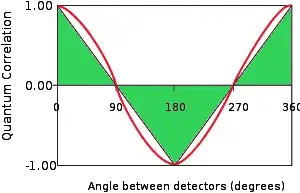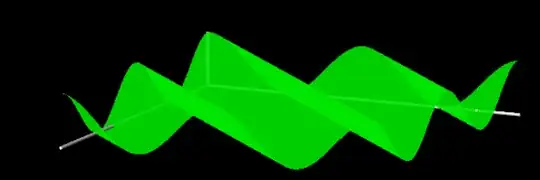Sorry for the provocative title. There's probably something wrong with my reasoning, and maybe someone will bother to point it out.
I did not understand Bell's Theorem, so I looked for easy explanations. I found one that looked very intuitive. They set up something like light polarization, but simpler. They explained that given "reasonable" assumptions, you must predict a linear change in correlation with the angle between detectors. The difference between 90 degrees and 91 degrees must be the same as the difference between 45 degrees and 46 degrees. But in fact it doesn't work that way, so the "reasonable" assumptions must be wrong.
That made sense. Then I found a coherent explanation with equations.
This elegantly describes what properties a "reasonable" set of assumptions must have, and describes an experiment that no "reasonable" assumptions can give a correlation better than .75 for. The claim is that QM predicts more than .75, and experiment is consistent with QM and not with "reasonable" assumptions.
Background
We assume there is some system state $\lambda$. There are two detectors $x, y$ which have outcomes $a, b$. Each outcome can only be 0 or 1.
The experimenters measure $p(ab|xy)$. They don't know $\lambda$, but they have estimated probabilities for some states that $\lambda$ might be in, so what they're really measuring is
$\underset{\lambda}{\sum}{p(ab|xy\lambda) p(\lambda|xy)}$
Further assumptions:
- $\lambda$ is not correlated with $x$ or $y$.
$$p(\lambda|xy)=p(\lambda)$$
Given that,
$$p(ab|xy) = \underset{\lambda}{\sum}{p(ab|xy\lambda) p(\lambda)}$$
- $x, y$ and $\lambda$ are enough to completely determine $a, b$
$$p(ab|xy) \in \{0, 1\}$$
That results in
$$p(ab|xy) = \underset{\lambda}{\sum}{p(a|xy\lambda) p(b|xy\lambda) p(\lambda)}$$
- $x$ does not influence $b$ and $y$ does not influence $a$.
$$p(a|xy\lambda)=p(a|x\lambda)$$
$$p(b|xy\lambda)=p(b|y\lambda)$$
So
$$p(ab|xy) = \underset{\lambda}{\sum}{p(a|x\lambda) p(b|y\lambda) p(\lambda)}$$
And from there he goes on to demonstrate the thing that can't correlate better than .75. It's very clear, I highly recommend it. He expands on that in a couple of later posts.
My efforts
Given this understanding, I tried an example, polarized light. Given a photon with linear polarization angle 0 and a polarizer with polarization angle $\theta$, that has two outcomes 0 and 1, the probability that the photon has outcome 0 is $\cos^2{\theta}$. I ran various simulations using Glowscript, a simple graphics programming system that often lets you see your mistakes in the way the pictures come out.
For every x and y between 0 and $2\pi$, I integrated over $\theta$ to get the probability that the outcomes a and b were the same.
If a and b were independent, then
$$p(a|xy\theta)=cos^2(x-\theta)$$
$$p(b|xy\theta)=cos^2(y-\theta)$$
$$p(ab|xy\theta)=cos^2(x-\theta)cos^2(y-\theta)$$
But for entangled photons, a and b are not independent. The closer x and y are to each other, the more likely that a and b are the same, regardless of $\theta$. (Oops! For experimental entangled photons, they are opposite and not the same. I'm sure the results are equivalent, though.) The formula is
$$p(ab|xy\theta)=p(a|x\theta)p(b|axy\theta)=cos^2(x-\theta)cos^2(x-y)$$
Graphed out, this looks like
(I went from 0 to $2\pi$ in each direction when it would have been enough to go from 0 to $\pi/2$, just in case my thinking was wrong and it would have made a difference.)
The correlation is the same whenever x-y is the same. This is just like the simple graph above except that one of the simplifications was to put the zeroes at 90 and 270 degrees, instead of at 45, 135, 225, and 315 degrees etc.
Again, the reason we get this result is that
$$p(ab|xy\theta)=p(a|x\theta)p(b|axy\theta)\neq p(a|x\lambda) p(b|y\lambda)$$
Photon polarization does not meet the criteria for Bell's inequality, which of course it must not or it could not be what it is. It looks to me like the assumptions behind Bell's inequality require that we must assume that the photons are not entangled. Assuming they are not entangled, of course we cannot get the same correlations we get when they are entangled.
Given that this is what it takes to get photon polarization to work, I didn't see why a deterministic system must fail. I quick found something that looked like it would work.
Each photon has three hidden variables. One is a polarization angle $\theta$ between 0 and 2 $\pi$.
Then there are two hidden variables $\rho$ and r between 0 and 1.
Same-entangled photons have all three of these variables the same.
To find whether a photon passes a filter with angle $\lambda$, calculate $\cos(\lambda-\theta)$. If $\rho, r$ are inside the square defined by (0,0) $(\cos(\lambda-\theta),\cos(\lambda-\theta))$ then it passes the filter.
Then set $\theta$ to $\lambda$. Multiply $\rho$ and r by 7 and discard any part of the results that are bigger than 1, to get their new values.
Question:
Since Bell's Theorem is correct, where did I go wrong?

